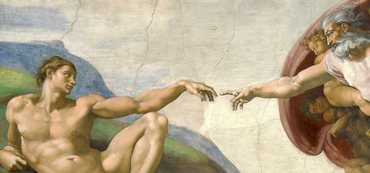How can we help?


The Engagement 4Cast

With the release of such new OS designs as Windows 8 and iOS 7, the world is becoming a bit simpler. It even seems like our favorite CMS, Drupal, is beginning to catch up with modern trends. The “flat” trend is not simply that, but rather a response to art as a whole. The same visual principles you see in technology and website design developed as a result of the greater fine art movements of today.
You can track web design in a similar way that art history progresses. Each movement rebels against the previous, always innovating and changing our perception of what’s fresh and exciting. Throughout art history, the themes of the ideal or perfect are in contrast to the real and gritty. Perfection begets reality. The decorative fights the informative. Craftsmanship versus showmanship. You can see the decorative and idealist concepts in Michelangelo’s overly-pronounced muscular figures and in ancient Roman proportions of the figure (a man being 8 heads tall instead of a more realistic 7). You can see the opposing ideas in the pragmatic documentation of Realism. It’s the juxtaposition that makes each interesting. Without one approach, you wouldn’t have the other. And so the cycle goes on.
These are the ideas that are still driving forces in today’s art and design, and I believe will be forever, in one form or another. Graphic design takes those concepts and uses them to communicate ideas. While graphic design is most often simpler than art due to its nature (presenting information clearly), it still wavers between the most simple styles like Bauhaus and Flat and the more decorative Grunge, Skeumorphic, and Victorian styles.
Design for web and other digital technologies are still catching up to print in regards to visual approach. Because digital technology is still in its infancy compared to art, it took a little while to start having real ‘movements’. Typography has had some great momentum with the advent of @font-face, and CSS3 has made much more possible online. It took these advances to make the first popular online design movement possible. Like artists who get a new tube of paint, web designers got CSS and used the hell out of it. “Oh goodness – I can make drop shadows easily now! No images! I’m going to use it on every block on the site!” Now that the excitement of newness is over, we can start to assess the value and proper use of such elements, and advance design.
It’s no wonder that parallax and skeuomorphism became popular around the same time in web – they follow similar principles of creating depth and making the page feel tangible. Now, to be new and fresh, designers are going in the opposite direction and getting rid of all depth. I predict that in the next few years, we’ll return again to a more decorative approach, but not in the same way as before. Perhaps it will follow similarly to the progression of paintings from the 1960’s to the 1990’s and we’ll get more abstract layouts and move away from the strict structure of today’s design. I’m looking forward to what’s next.
If you’d like to read more, here’s the post that got me thinking: punchcut.com/perspectives/posts/windows-8-new-modernism
Example of skeuomorphism and depth
eastafricanbakery.comExamples of the transformation from depth to flat (some deep elements, some flat)
sachagreif.com
en.ijb.ca
apple.comExamples of the extreme – all flat all the time
rdio.com/ (with the exeption of the sweet blend modes on the photos, which would be great in print, too)
npr.org/blogs/thetwo-way
windows.microsoft.com
For the Drupalers out there, what do you think of the progression of the standard Drupal theme (visually speaking)? Do you want to keep the 3-Dimensional button styles, or move into the flat realm? I’ve been using alternative admin themes to simplify my content creators’ experience – do you?

4Site Studios is a talented troupe of web professionals who are passionate about creating tools to support digital marketers. We love to hear from our community! Reach out to us with your thoughts and questions. And don’t forget to subscribe below to get notified when we post new blogs – no spam, just content👍🏼
Subscribe to the Engagement 4Cast.

